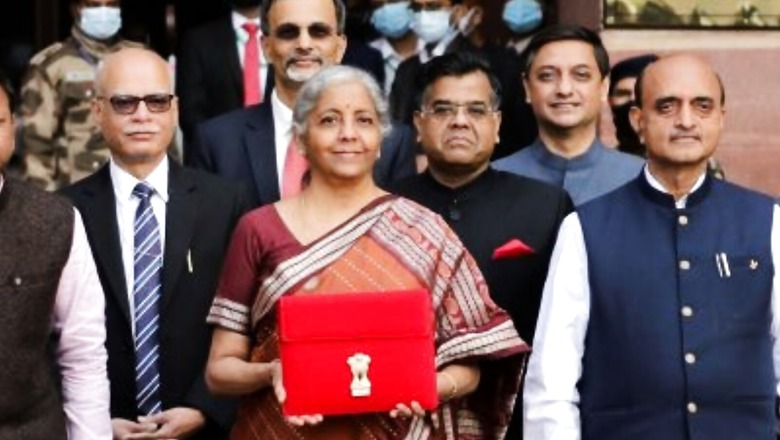
views
Finance Minister Nirmala Sitharaman on Tuesday presented the tenth Budget of the Narendra Modi government. It was the penultimate full budget of his current tenure. This year, the Union Budget was a tough ropewalk amid competing pulls from various directions in the backdrop of Omicron-led third wave, depressed state of private consumption and an equally difficult private investment scenario. And, this being the election season, when a big state like Uttar Pradesh goes to polls, made the task of the finance minister arduous.
Conventional wisdom dictated presentation of a populist budget that played to the gallery and focused on doles. No one would have found fault with Sitharaman had she chosen to tread the oft-travelled path.
But, by turning contrarian and desisting populism while keeping single-minded focus on pump-priming the economy to achieve inclusive and sustainable growth, she has charted the correct path to focus on the new vision of Mission India @2047 — 25 years of Amrit Kaal, from India@75 to India@100.
Before capturing what Budget 2022 has attempted, it is instructive to recapitulate its few nuances.
One, Nirmala Sitharaman’s Budget speech, probably her shortest so far, had far more depth and punches than what ‘experts’ had expected.
Two, while focusing on the next level of ease of living and ease of doing business, she refreshingly ensured directional continuity with the budgets from previous years.
Three, by not tinkering personal Income Tax rates while improving the ease of compliance, and with no negative surprises like increase in capital gains tax, wealth tax etc., she has ensured stability of the tax regime.
Four, despite being flush with tax and other receipts in FY2022, she eschewed freebies and in a bold move, drastically reduced the fertilizer, food and petroleum subsidy.
The finance minister did an unthinkable first — allocating more than Rs 10,00,000 crore (Rs 10,67,889 crore to be precise) towards FY2023 capital expenditure (capex), a whopping 61.54 per cent more than Rs 6,57,182 crore in FY2021.
Even if we take out the portion of grants for creation of capital assets, the FY2023 capex budget is Rs 7,50,246 crore against revised capex budget of Rs 6,02,711 crore for FY22 and the actual budget of Rs 4,26,317 crore in FY 2021.
It is this singular focus of taking capex expenditure to unprecedented levels despite all the headwinds and opportunities to spend elsewhere is what separates this year’s Budget from the earlier ones.
It also makes Budget 2022 very special.
Quite clearly, in place of playing to the gallery with doles and welfare schemes, the finance minister has gambled heavily on capex and infrastructure development-led inclusive and sustainable growth story, which also focuses on creating substantial direct and indirect employment in the next five years.
The big story of Budget 2022 is laying the blueprint for Amrit Kaal vision — India@75 to India @100 — with focus on:
“Complementing macroeconomic growth focus with micro economic all-inclusive welfare focus; promoting digital economy and fintech, technology enabled development, energy transition, and climate action, and and finally relying on virtuous cycle starting from private investment with public capital investment helping to crowd-in private investment.”
If indeed these desirables are achieved, 21st century will be an Indian century.
Although audacious, it is achievable if the vision is married with excellence in execution to catapult Indian GDP to $25-30 trillion by the time India turns 100, with $5billion in 2025 being the launch pad. Those who doubt doability of these numbers must note that in the last nine years, China added $10 trillion to its GDP.
Gati Shakti
Much of the Nirmala Sitharaman’s Budget is about Mission India@2047 and laying the groundwork for it by focusing on futuristic and inclusive development, creation of world-class infrastructure using four key pillars. These pillars are: PM Gati Shakti; inclusive development; productivity enhancement and investment, sunrise opportunities, energy transition and climate change; and innovative financing.
The Budget expands on the Gati Shakti programme, describing it as an audacious transformative approach for economic growth and sustainable development, powered by seven growth propellants — “Roads, Railways, Airports, Ports, Mass Transport, Waterways, and Logistics Infrastructure”.
The Gati Shakti architecture is ably supported by the complementary roles of Clean Energy, IT and Communication, Bulk Water and Sewerage, and Social Infrastructure.
The Budget emphasises that Gati Shakti apart from being the growth propeller will be a substantial job generator as well. It will substantially benefit from coordinated planning with state governments, innovative finances, use of cutting-edge technology and focused speedier execution.
Gati Shakti’s aim: world-class modern infrastructure, substantially synergetic low-cost logistics, improved levels of productivity and accelerated inclusive economic growth.
From a directional point it is a bold Budget, but it is short on numbers regarding the seven pillars. The documents ‘Budget at a Glance’ and ‘Budget Speech’ conceal much reveal little beyond a block number Rs 3,51,851 crore under ‘Transport’ and another Rs 76,549 crore under ‘Urban Development’.
Railways, Highways and Urban Transport
Let us now look at railways, highways and urban transport.
First, Railways. Ever since the Railway Budget got merged with the General Budget six years back, railways have at best found a place along the margins of the annual Budget. This year is no exception. The capital outlay at Rs 2.45 trillion for FY2023 (of which Rs 1.37 trillion is from general revenue) is marginally up from the revised outlay of Rs 2.15 trillion in FY2022.
The announcement of 400 new-generation Vande Bharat trains, 100 PM Gati Shakti Cargo terminals, 2000 km of “Kavach” safety and “one station one product” are notable but still scratch the surface and do not solve structural deficiencies in the system.
Possibly, Indian Railways bigger problem cannot be solved under public glare — that it is terminally sick, both financially and institutionally, and needs re-booting. Fortunately, the Budget does not follow up on the recent recommendations of the finance ministry to carry out complex and undesirable mergers among listed railway PSUs without sufficient justification.
Second, Roadways. Unlike railways, the focus is clearer for this sector: expansion of highways by 25000 km in FY2023 including through innovative financing, focus on creation of at least four multi-modal logistics park in FY2023 through PPP, and substantive provisioning of electric vehicle (EV) charging infrastructure. Quite clearly, the road versus rail bias persists.
Third, urban development and mass transit. Till recently, the website of urban development ministry displayed what Gandhiji once said – ‘India stays in its villages’. Focus on urban development has been recent, in hindsight and almost apologetic, despite experts predicting that 600 million Indians will stay in cities and towns by 2030.
Current Budget marks a clear shift. First, it acknowledges that by 2047, 50 per cent Indians will stay in cities and town; second, it calls for reimagining cities and for a paradigm shift; third, it urgently seeks to establish a panel of specialists; fourth, it re-emphasises need for massive investment in appropriate type of metro and other urban transport systems with multi-modal connectivity. Lastly, it is clear that urban transport systems need India-centric design and standardisation. Better late than never!
As the author said ab-initio, this Budget is transformational in nature and directionally correct.
If it does not categorically talk about every number in detail and does not show the fine print of financial outlay for everything announced in the Budget speech, that is no big deal. After having dreamt audaciously big, what matters is implementation, implementation and implementation. Money will come if there is a will and there is a sense of direction.
This is part one of a two-part series by the author on Budget 2022.
The author is an infrastructure expert and President, Advisory Services, BARSYL Limited. The views expressed in this article are those of the author and neither represent the stand of this publication nor the author’s company.
Read all the Latest Opinions here




















Comments
0 comment